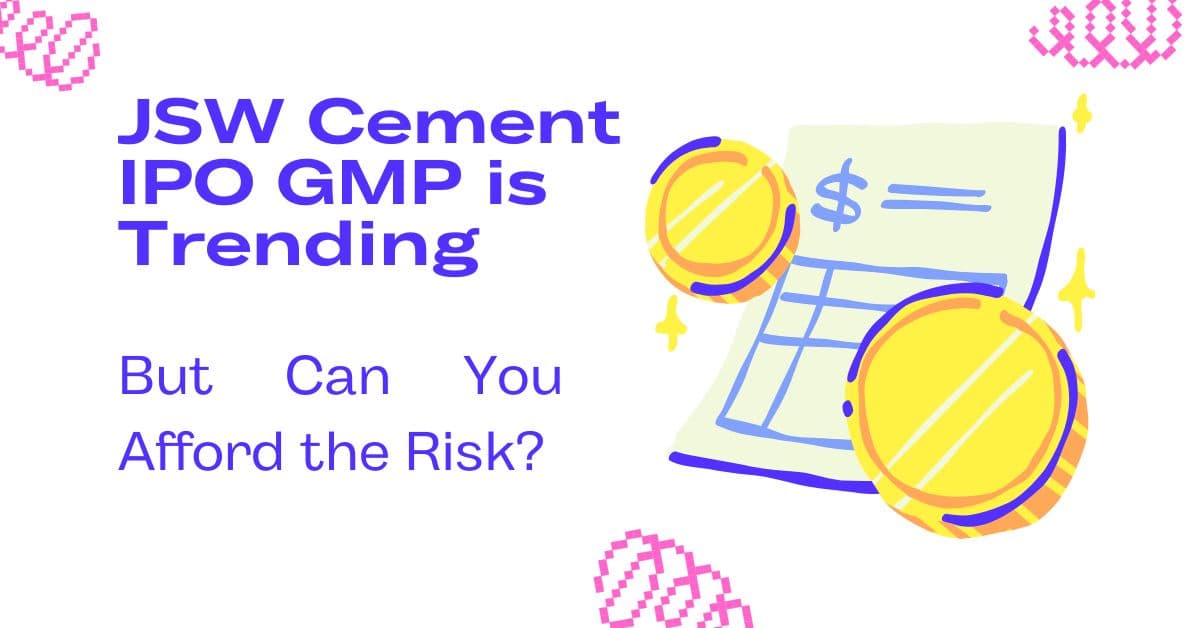JSW Cement IPO GMP: A grey market premium (GMP) of around ₹19, indicating a possible listing price of approximately ₹166—a 12.9% increase above the top price range of ₹147—has generated a great deal of enthusiasm in India’s financial community for the JSW Cement IPO, which opens on August 7, 2025. JSW Cement, a prominent producer of environmentally friendly cement that takes advantage of India’s infrastructure development, is a member of the JSW Group, a reputable brand in the Indian business. Retail investors are taking notice of the IPO, which has a ₹3,600 crore issue size, although there are worries about its high debt levels and recent financial loss of ₹163.77 crore in FY25. Can you afford the risk? is the issue for new investors. In order to help you invest sensibly in 2025 without jeopardising your financial security, this guide examines the JSW Cement IPO, its GMP, investing potential, risks and five useful budgeting advice.
Understanding IPOs and GMPs
A private corporation may sell shares to the general public through an initial public offering (IPO), giving investors the opportunity to purchase stock. The price at which IPO shares trade on the grey market prior to listing is reflected in the Grey Market Premium (GMP), an informal measure of demand. A positive GMP, such as ~₹19 for JSW Cement, indicates investor optimism and may result in listing gains. But since market circumstances, subscription rates, and economic considerations can affect the listing price, GMP is speculative and not a reliable indicator of success [Chittorgarh].
Key Information for JSW Cement’s IPO
Through a new issuance of 10.88 crore shares (worth 1,600 crore) and an offer for sale (OFS) of 13.61 crore shares (worth 2,000 crore), the JSW Cement IPO is a book-built offering with the goal of raising ₹3,600 crore. Allotment is anticipated on August 12 and listing on the BSE and NSE on August 14, 2025. The initial public offering (IPO) is run by JM Financial Limited and others, with Kfin Technologies Limited serving as the registrar. Subscriptions will be accepted from August 7 to August 11, 2025 [IPOWatch]. With a minimum lot size of 102 shares and a price range of ₹139–₹147 per share, a retail investment of ₹14,178–₹14,994 is needed.

Allocation of IPO Proceeding:
- For a new integrated cement factory in Nagaur, Rajasthan, ₹800 crore has been allocated.
- ₹520 crore to pay off debt (as of March 31, 2025, total borrowings were ₹6,166.6 crore).
- The remainder will be used for regular business needs [News18].
GMP Insight: As of August 5, 2025, the listed price is ~₹166 (12.9% premium), with a GMP of ~₹19. Although some sources claim it as not yet begun or zero, illustrating its volatility, the GMP increased from ₹0 on August 4 to ₹19 on August 5, suggesting rising investor interest [Financial Express]; [NDTV Profit].
| IPO Detail | Value |
| Issue Dates | August 7-11,2025 |
| Price Band | ₹139-₹147 per share |
| Lot Size | 102 shares (₹14,178-₹14,994) |
| Issue Size | ₹3,600 crore |
| GMP (Aug 5,2025) | ~₹19 (~₹166 listing price) |
| Allotment Date | August 12, 2025 |
| Listing Date | August 14, 2025 (BSE, NSE) |
Overview of the Company
One of the leading cement producers in India, JSW Cement Limited is a division of the Sajjan Jindal-led JSW Group. It specialises in environmentally friendly goods such as ground granulated blast furnace slag (GGBS), which makes up 80.68% of sales. As of March 31, 2025, the company has seven plants in Andhra Pradesh, Karnataka, Tamil Nadu, Maharashtra, West Bengal, and Odisha with an installed grinding capacity of 20.60 million metric tonnes per annum (MMTPA). This gives it an 84% market share in the production of GGBS [Groww]. With the lowest CO₂ emissions in the sector, its emphasis on sustainability fits perfectly with India’s drive for green infrastructure. Taking use of the ₹11 lakh crore National Infrastructure Pipeline [Angel One], JSW Cement intends to increase capacity to 40.85 MMTPA.
Financial Performance
The financials of JSW Cement demonstrate a mixed performance:
- Revenue: For FY25 was ₹5,813.1 crore, a little decrease from FY24’s ₹6,028.1 crore and FY23’s ₹5,836.72 crore.
- Net Profit: FY25 saw a loss of ₹163.77 crore, whereas FY24 and FY23 saw gains of ₹62.01 crore and 104 crore, respectively.
- CAGR (FY23–FY25): 15.05% in sales volume and 12.42% in grinding capacity, above the industry’s 6.23% [Groww].
- Debt: As of March 31, 2025, the debt was ₹6,166.6 crore, of which ₹520 crore was paid back from the IPO [News18].
- P/E ratio: Because of the FY25 loss, the P/E ratio is not valid, which raises questions regarding value.
Although the company’s rise in capacity and sales volume implies long-term potential, investors are particularly at risk from the FY25 loss, which was caused by expansion expenditures and market issues [Trade Target].
| Financial Metric | FY25 | FY24 | YoY Change |
| Revenue (₹crore) | 5,813.1 | 6,028.1 | -3.6% |
| Net Profit (₹crore) | (163.77) | 62.01 | Loss |
| Debt (₹crore) | 6,166.6 | – | – |
Investment potential
The cement sector in India is expected to expand due to:
- Infrastructure Boom: Government programs like PMAY and the ₹11 lakh crore National Infrastructure Pipeline drive demand for cement [Equitymaster].
- Market Growth: According to [Angel One], the industry is anticipated to add 80–100 million tonnes of capacity by 2025, with a 6% CAGR.
- Sustainability Trends: JSW Cement’s emphasis on green cement complies with both customer expectations and environmental standards.
Analyst Opinion:
- Optimistic Views: Given the ₹19 GMP, analysts including those at Motilal Oswal believe that JSW’s market leadership and development ambitions will provide long-term potential, with listing profits probable [IPOCentral].
- Cautious Views: According to [Financial Express], several experts advise a “Hold” until profitability stabilises due to the FY25 loss and significant debt. This uncertainty is increased by the volatility of the GMP (₹0 to ₹19 in days).
Although a 12.9% listing gain is suggested by the GMP of ₹19, post-listing revisions may result from high subscription rates in comparable IPOs (e.g., 55x for GNG Electronics) [Chittorgarh]. While short-term investors run the risk of volatility, long-term investors could profit from JSW’s expansion objectives.
Risks To Consider
There are many risks associated with investing in the JSW Cement IPO:
- Financial instability: Concerns over short-term profitability are raised by the FY25 loss of ₹163.77 crore in comparison to previous earnings [Trade Target].
- High Debt: If income growth slows, ₹6,166.6 crore in borrowings, even with partial repayment, might put a burden on finances. [News18].
- Industry Cyclicality: The demand for cement is influenced by real estate, infrastructure expenditure, and economic conditions, all of which can fluctuate [Economic Times].
- Competition: JSW’s market share is under threat from rivals like UltraTech, ACC, and Ambuja Cements [Screener].
- GMP Volatility: Conflicting reports (some stating zero) and the GMP’s sharp increase from ₹0 to ₹19 underscore its instability [NDTV Profit].
Can You Afford the Risk?
Many people can afford the minimal investment of ₹14,178 to ₹14,994, but the risks—high debt, market rivalry, and financial loss—need to be carefully considered. For beginners:

- High-Interest Debt: The expected 10–15% profits from the IPO are outweighed by the savings from paying off credit card debt (20–40%) and personal loans (10–20%). Clearing a ₹50,000 credit card at 36%, for instance, saves ₹18,000 a year, which is significantly more than the ₹1,500 profit on a ₹10,000 investment at 15% [Financial Express].
- Lack of Emergency Fund: Selling shares during a dip (such as a post-listing correction) might result in losses if you don’t have three to six months’ worth of costs saved [Policybazaar].
- Risk Tolerance: A modest commitment (5–10% of your portfolio) can be feasible if you have disposable income and can afford to lose the investment. If not, give financial stability top priority.
It is advised that long-term investors with a solid financial foundation apply for one or two lots and hold them for more than a year in order to take advantage of the cheaper long-term capital gains (LTCG) tax (12.5% over ₹1.25 lakh vs. 20% for STCG). Investors who are risk averse should wait for Q2 FY26 data (October 2025) or post-listing stabilisation before evaluating profitability [Moneycontrol].
Budgeting Advice for Secure Investing
Use these five budgeting techniques to invest in the JSW Cement IPO without experiencing financial hardship:
- Clear High-Interest Debt: Pay off personal loans or credit cards first to eliminate high-interest debt. For instance, using a ₹50,000 credit card at 36% and paying ₹5,000 a month saves ₹18,000 a year [Financial Express].
- Create an Emergency Fund: To prevent selling shares during volatile times, put ₹1.5–₹3 lakh (three to six months’ worth of expenditures) in a high-yield savings account with [HDFC Bank] or [SBI] [Policybazaar].
- Follow the 50/30/20 Rule: which states that 20% of income should go towards savings or investments, 30% towards desires, and 50% towards requirements. Set aside ₹10,000 for savings and ₹1,000 to ₹2,000 for the IPO for a monthly income of ₹50,000 [NerdWallet].
- Start Small with Dollar-Cost Averaging: To lower volatility risk after listing, invest between ₹14,178 and ₹28,356 (1–2 lots) and utilise dollar-cost averaging (e.g., ₹2,000 monthly) [Zerodha].
- Diversify Your Portfolio: To reduce sector risks, keep JSW Cement to 5–10% of your portfolio and balance it with fixed deposits or Nifty 50 index funds. [Groww].
The foundation of effective personal finance, particularly for young investors and earners, is an efficient budget. First, pay off high-interest debt, like as a credit card balance of ₹50,000, to save up to ₹18,000 a year, which is more than many IPO returns. Create a ₹1.5 lakh emergency reserve to prevent being compelled to sell amid volatile markets. Follow the 50/30/20 budgeting guideline, which states that investing ₹10,000 of a ₹50,000 salary guarantees financial discipline. To lower risk while increasing exposure, start small by investing as little as ₹14,178 in 102 shares of JSW Cement. Lastly, to reduce sector-specific risk, diversify your portfolio by investing ₹50,000 in a Nifty 50 index fund.
How to Invest in the JSW Cement IPO?
At 5:00 PM IST on August 11, 2025, the JSW Cement first public offering (IPO) concludes. Here’s how to get involved:
- Open a Demat Account: Use digital KYC (PAN, Aadhaar, bank data) to register with SEBI-regulated platforms such as [Zerodha], [Groww], or [Upstox].
- Register for the IPO: By logging into your trading account, choosing JSW Cement IPO from the IPO section, picking lots 1–13 (102–1,326 shares, ₹14,178–₹194,922), choosing the bid price (₹139–₹147), and confirming with ASBA or UPI.
- Check Allotment: On August 12, 2025, check the status on the BSE/NSE or [Kfin Technologies] websites. The first day of refunds is August 13, 2025.
- Post-Listing Trading: Use the designated ticker to purchase shares on the BSE/NSE starting on August 14, 2025.
- Monitor Performance: For information on Q2 FY26 results (October 2025), follow prices and news on [Moneycontrol] or [NSE India].
Frequently Asked Questions (FAQs)
1. What is the GMP for the JSW Cement IPO?
A listing price of ~₹166 (12.9% premium) is suggested by the GMP of ~₹19 as of August 5, 2025 [NDTV Profit].
2. Can I afford the IPO for JSW Cement?
A minimum investment of ₹14,178 to ₹14,994 is required. Prioritise financial stability over investing if you lack an emergency fund or have high-interest debt [NerdWallet].
3. Is JSW Cement’s IPO risky?
Yes, because of the competitiveness, heavy debt, and the FY25 loss. Only invest your disposable income and diversify your investments [Financial Express].
4. When will JSW Cement go public?
On August 14, 2025, it lists on the BSE and NSE, and on August 12, 2025, the allocation was finalised [IPOWatch].
5. How can I make safe investments?
Reduce high-interest debt, invest modestly, diversify with mutual funds, and save for emergencies [Groww].
An Example from Real Life
Situation: Priya, a 30-year-old Bengaluru professional who makes ₹50,000 a month, owes ₹50,000 at 36% on her credit card debt. She is interested in the IPO of JSW Cement.
- Action: Priya would save ₹18,000 in interest by paying ₹5,000 a month to pay off her loan in about ten months. She uses [Groww] to apply for 1 lot (102 shares, 14,994) after building up a 1.5 lakh emergency fund. She uses [Money View] to manage her spending and diversifies with a ₹2,000 monthly SIP in a Nifty 50 fund.
- Result: Her investment increases to ₹16,932 if shares list at ₹166, representing a gain of ₹1,938 (12.9%). She makes safe investments by putting debt and diversity first.
Conclusion
With a GMP of around ₹19 and a possible listing price of about ₹166, the JSW Cement IPO presents an opportunity to invest in a top producer of green cement. However, it is a risky investment for beginners due to its competitive business, huge debt, and FY25 loss. Make financial discipline a priority by paying off high-interest debt, setting up an emergency fund, and making modest, diversified investments. Before August 11, 2025, apply through [Zerodha] or [Groww], keep an eye on [Moneycontrol] for changes, and speak with a financial counsellor to make sure your plan is in line with your objectives. Make the most of this chance in 2025!
Disclaimer: There are risks associated with investing in equities and initial public offerings (IPOs), and historical performance does not guarantee future outcomes. Before making an investment, speak with a knowledgeable financial counsellor. This article is just meant to be instructive.
Nifty Share Price Alert: Clear Your Debt Smartly in 2025
NSDL IPO Price Revealed – Smart Debt Management Tips for 2025 Investors!
Zomato Share Price Today: Invest or Pay Debt First?

I’m Rashid Ali, a personal finance blogger and content creator at SavingSecret.in, helping young adults in India master saving, investing, and tax planning. I simplify money topics like budgeting, IPO updates, and stock market tips to make finance easy and actionable. Follow me for smart money moves that actually work!
